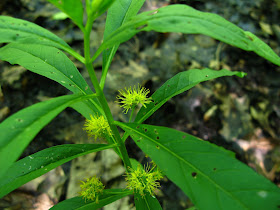It's enough to make me
really believe in the power of Original Sin. Here I was, in Paradise -- meaning Pyramid Lake, a pristine wilderness lake surrounded by mountains and forest (see photos, previous post), gorgeous weather, clear starry nights, and I had the place all to myself. Except for the damned black flies. One foot out the door, and a ravenous cloud surrounded my head, chewing chunks from my neck, my ears, my temples, flying up my nose, getting stuck in my eyes, keeping me awake all night with the terrible, burning itch. Bug dope only seemed to make me tastier to them. AAARGH!!!
But did that keep me out of the woods? Just take a guess! There were boreal forest and cold bog plants to be found and this was my only opportunity to find them. And I was richly rewarded for my (literal!) pains. On the rocky banks along the dirt road leading into camp I found Purple Virgin's Bower (Clematis verticillaris) twining along a boulder, set off nicely by white clouds of Early Saxifrage. This is a native clematis, more demure than its showy garden counterpart, threatened or endangered in many neighboring states, and not so easy to find in New York either. I couldn't find it the last two years, and I knew where to look. On the same stretch of road I also found Skunk Currant (Ribes glandulosum), another seldom encountered plant, but not so photogenic. A little bit stinky, too. But still, a first for my life list.

The purple sepals of Purple Virgin's Bower are almost transparent, like organdy.
I next went in search of Creeping Snowberry (Gaultheria hispidula), another plant that's having a hard time finding a place to live in surrounding states. But I knew where to find it, same place I look every year. I always find the tiny, tiny creeping leaves covering an old stump in a springy area, but hardly ever the flowers. They're so tiny and hidden beneath the leaves, it's easy to overlook them, no matter how hard I search. This time I found them. Aren't they cute?

Creeping Snowberry blooms are tiny (1/8 inch) and hide beneath the leaves.
Along that same damp trail I always find a flower that USDA says doesn't exist in New York State. But Rosybells (Streptopus roseus) certainly thrives near Pyramid Lake. You may pass by it, thinking it's Solomon's Seal; the little pink bells dangling beneath the leaf stalk are very easy to miss. I only found them this week because I've found them here before.

Rosybells are also called Rose Twisted Stalk. You have to twist up the stalk to see them.
The black flies were not quite as bad out on the water, but the wind was blowing so hard I couldn't take many photos. I'd just get a shot in focus, and my boat and I would go flying away beyond the focal length. I managed to wedge my canoe between fallen logs in a swampy end of the lake to get this photo of Round-Leaved Sundew (Drosera rotundifolia) glistening on a stump. These sodden and decaying logs are colonized by an amazing variety of plants. On just one log I counted Sundew, Marsh St. Johnswort, blueberries, cranberries, Purple Cinquefoil, Rose Pogonia, Green Wood Orchis, Marsh Speedwell, and mosses, grasses, and ferns I don't know the names of. Not all are in bloom this week, but I could see by their leaves they were coming.

Round-leaved Sundew lures bugs by its dewy beads, then closes its spines over the bug and eats it.
As soon as I spotted Mama Loon, I quickly backpaddled before she spooked and tore away with whumping wingbeats from her nest. Loons lay only two eggs at a time, and if Mom leaves her nest for too long a time, the eggs won't hatch. Sorry I got so close, Mrs. Loon. (I wasn't actually as close as this photo makes it appear: I used my zoom. And then I cropped.)

This symbol of northern lakes finds fewer and fewer places to rear its young.
Pyramid Lake offers fine nesting sites for this water bird whose haunting call is the signature sound of the northern forest. The lake is surrounded by the Pharaoh Lake Wilderness Area, with the only automobile access through Pyramid Life Center, a spiritual retreat center committed to maintaining the wilderness environment. No motor boats (whose wakes can swamp nests) are allowed on the lake, and once a nest has been sighted, all paddlers are warned to keep away. Then we all wait and watch for those two downy dumpling-chicks, sometimes riding along on Mother's back. Mom and Dad both dive down and catch fish and then feed them to the young, even after the young are as big as their parents.
Too bad they don't eat black flies.





















































